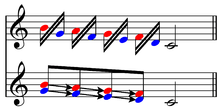Unfolding (music)

Unfolding: outlining thirds through skipping between the upper and lower notes  Play .
Play .
In Schenkerian analysis, unfolding (German: Ausfaltung) or compound melody is the implication of more than one melody or line by a single voice through skipping back and forth between the notes of the two melodies. In music cognition, the phenomenon is also known as melodic fission.
Unfolding is a type of prolongation, "by means of the unfolding of intervals horizontally."[1] Though the notes skipped between, those heard, may be considered near the foreground, the dyads, those implied, are in the middle or background. Middleground dyads are "unfolded" in the foreground: "intervals conceptually heard as sounding together are separated in time, unfolded, as it where, into a melodic sequence."[2]
See also
References
| |||||||||||||||||
This article is issued from Wikipedia - version of the 2/4/2015. The text is available under the Creative Commons Attribution/Share Alike but additional terms may apply for the media files.
